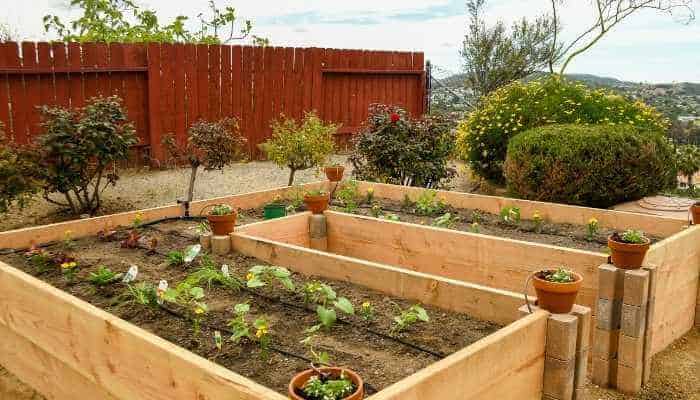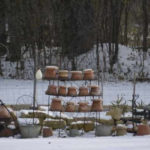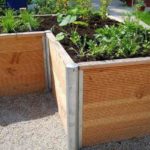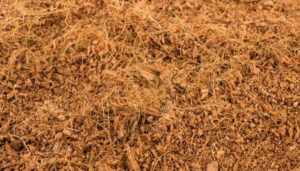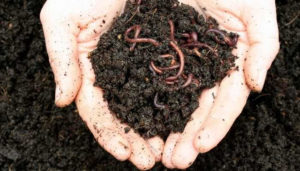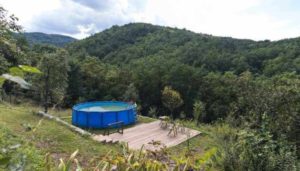The material you choose for your raised garden beds all depends on your budget and what materials you might have access to. In some cases, we just used what we have available, and that’s fine. But the question is, what are the best materials available for building your raised garden beds?
The best material for raised garden beds is corrugated galvanized metal. A good second choice would be 2inch thick cedar or redwood boards. In both cases, the main material should be well-framed and anchored.
There may be better materials out there, but these are the tried and true materials. I would really like to do a bit more research on the fabric beds and the beds made of recycled materials made into modular raised garden beds. But until then, I’ll tell you all about them. If they wind up being better than the wood and galvanized metal, I’ll revisit this article.
Since not everyone will have access to or be able to afford these materials, I wanted to also cover alternatives that you might have overlooked! After all, you can honestly use just about anything that’s capable of withstanding moisture and can hold soil in place as a garden bed. Let’s dive in!

Common Materials to Build Raised Garden Beds
I have seen raised garden beds made of metal, wood, and concrete. I have also seen containers used as raised garden beds, because why waste a container? I have seen old pallets used for an interesting couple of takes on gardening as well.
But, just because I’ve seen it, doesn’t mean it’s the best. And just because I haven’t seen it, doesn’t mean it won’t work! Remember, I DO NOT use organic gardening rules. I use practical gardening rules and love to upcycle older materials. So, some of these materials, organic gardeners may not be able to use.
The best materials for building raised bed gardens are going to be strong, durable, and safe. Raised garden beds have to be made of materials that can withstand the pressure from a load of soil in them without bowing and they also have to last despite being in contact with a lot of moisture.
I’m also adding a section at the bottom of this article specifically for materials that are not safe to use for your raised garden beds. So keep reading!
Types of Wood to Make Raised Garden Beds
You can use almost any type of wood for making raised garden beds. The main things to consider no matter which type of lumber you choose is to keep your side boards at 2inches thick and don’t be lazy with the supports you use in them. Also, make sure they drain well, and if you want to use a sealant, there are non-toxic ones available for you to use.
What Is The Best Wood To Use For Raised Garden Beds?
Cedar and its larger cousin – Redwood – are the two kinds of wood best suited for being used in making raised garden beds. These kinds of wood are termite resistant. They also are naturally resistant to moisture and therefore rot. The wood is strong and durable. If the construction of your bed is appropriate, a cedar or redwood bed should last at least a decade. That’s why we also recommend it for outdoor furniture.
If you’re like me and want to think of the environment first in everything, look for the “FSC” certification on your lumber. It means that the lumber comes from an area regulated by The Forest Stewardship Council. Also if you use redwood, get heart redwood, which lasts longer because it’s denser.
There are other lumbers that are less expensive than cedar or redwood, though not as durable. Those may be what your budget calls for: pine, fir, etc. So long as you always use boards that are 2 inches thick for your sides, and you anchor and reinforce all of the beds, you should have beds that will last at least seven years, if not more. To make them last even longer, you can purchase non-toxic sealants – especially helpful if you live in climates that are prone to rain and humidity.
How Long Will Untreated Wood Last In Raised Beds?
How long untreated wood lasts in a raised garden bed depends on several factors. First – what kind of wood is it? Second – how thick did you get the side boarding? Do you plan on using a liner of some sort between the wood and the soil? See? This isn’t an easy question to answer.
What I can give you is an estimate. As stated before untreated cedar and redwood can last well over 10 years. Fir and pine can rot after about 5 – 7 years. If you make sure your beds have adequate drainage you can possibly increase the life of the things by a few years.
Can You Use Treated Lumber For Raised Garden Beds?
You can use pressure-treated lumber for your raised garden bed – technically. It is not supposed to have enough bad chemicals in it to cause any health issues. However, I don’t see the point in taking the chance. It’s really not going to last much longer than the other untreated softwoods, despite being treated! And if you’re into organic farming, you absolutely cannot use it.
Metal Raised Garden Beds
I started noticing raised beds made of metal about two years ago, but they’ve become more and more popular. The first ones I noticed were simply people converting watering troughs and animal feed containers into raised beds. Then came makeshift raised garden beds made of corrugated steel and then manufactured versions hit the market.
These types of raised bed gardens can be cost-effective compared to most wooden raised beds, because if you get galvanized metal – it won’t rust. Metal is stronger and resists bowing as well. But, if you’re worried about that, more support can be maintained.
Some people worry about soil overheating in a metal container, but so long as the soil has plenty of oxygen and is kept at the proper moisture level, that should not be an issue. Also, so long as the metal is well-made and galvanized, there should be nothing dangerous to leach into the soil. Just watch out for corrosion – for one thing, you may want to take that back and get a refund, but also it could be bad for edibles.
Converted Metal Containers
It is easy as pie to convert a watering trough into a raised bed garden. Drill holes for good drainage in the bottom of it. Then set it where you want it. If it’s on an incline, maybe add some anchoring around it. Then fill it up and begin using it.
You will pay more for a smaller prefabricated raised bed garden made out of the same materials. At least, that’s what I am finding on average. And who knows? You may be able to go to auctions or local vendors and find a better deal.
Corrugated Metal Raised Garden Beds
I have seen several of these beds as I walk through neighborhoods. I think the first time was in Carrboro, NC. If you ever get to that area, definitely go walk around the town for great gardening ideas. Anyway, I saw a local teahouse also use this method long before any manufacturing company began making them.
All you have to do is buy corrugated metal and 2×4 wood or metal fencing stakes to use as your four corners to anchor it and for any framing, you want to add. Then, you use the metal sheets as your sides by attaching them to your anchors and frame. Most sheets come as 6×2 ¼ so they are essentially a perfect fit for a raised garden bed.
Now, there are companies that have capitalized on this trend by manufacturing easy-to-deliver, prefabricated versions of this kind of bed in multiple sizes. They’re perhaps a bit more expensive, but they are often less work and easier to place and fit into a yard.
Even major home improvement stores carry their own versions, now. I’ve not tried any, but I believe there may be some on Amazon that are not quite as expensive but I also believe they may be shorter than I would recommend.
Making Raised Garden Beds from Masonry Materials
Concrete, brick, block, or cinder block can be used for constructing a raised garden bed. This kind of material is durable and sturdy, though it can blow a budget. Also, these planters are usually permanent structures. So there will be no moving them.
I’ve seen some homes with very expensive concrete planters – though very rarely do they have actual edible plants growing in them. I believe what is more cost-effective and yet lovely are decorative blocks, brick, and some stones made of concrete.
Whether they are stacked or placed, keep in mind that the adhesives and mixtures used to make these planters need to completely dry and cure before you add your soil and plants. That way there is no chance of toxins getting into the soil. You can also find mortarless systems that can be placed, so you take even less risk.
Are concrete blocks or cinder blocks safe for gardening? Yes. Always keep in mind limiting adhesive and mortar, but if you make sure all of these things are dry and cured you should be good. There has been concern over some masonry additives holding on to heavy metals. Scientific studies performed have shown no risks from materials purchased from reputable sources wherein the question can be asked about the safety of building with the materials for a planter that holds edible plants.
I personally have used several variations of this in my yard and I’ve never really had any issues with it. I’m no scientist, though, so, do your own research on this. If you want to be cautious, use these kinds of materials for making containers to hold your non-edible plants.
Natural Stone Raised Beds
Stacked stone walls or large natural stones and boulders can make up the sides of your raised garden beds, too. The difference between them and masonry is that there usually isn’t much fear of having unknown metals and chemicals being released into your soil from a natural stone. Unless it was found in a place where chemicals may have leached into them? They should be fine.
They can be free-stacked, and if you decide to glue or use mortar, just remember to let it dry and cure or use just enough at the center of the stones so that the stones don’t move, but the soil doesn’t get to it. Either way and you should be good to go. This material though it’s durable and sturdy, it is also very expensive.
Also, keep in mind that natural stones don’t come in any one shape or thickness. If you’re building something with these stones, it’ll be like putting puzzle pieces together. I don’t think I would use this material for more than maybe one bed – and that bed would be the centerpiece of my garden. They are just too showy, expensive, and difficult to work with to do otherwise. I know. I’ve used them before.
Why Do People Love Fabric Raised Beds
A relatively new thing that I’ve seen is fabric raised beds. There are several companies that distribute these alternatives to the larger, heavier, more expensive materials we normally see. These things are great with drainage and aeration, and they resist mold and rot. These fabric raised garden beds usually come with easily assembled, nontoxic framing and can be placed anywhere it fits.
It sounds to me like the fabric raised garden beds are something worth looking into, but since I don’t have any experience with them, I don’t feel comfortable suggesting them above more traditional materials. I can only tell you what I’ve found out about them and let you make the determination. The fact that they’re so portable and have a low price point makes me all the more curious.
Composite Raised Garden Bed Kits Are a Thing
Yes, you heard it! I suppose it was only a matter of time. If we’re making homes and furniture out of composites, why wouldn’t we have raised garden beds made out of them? They are advertised as easy to assemble, non-toxic, and made with recycled materials. I feel like they look a lot nicer than most of the materials in this article.
Are they affordable? Well, they’re definitely out of my budget. A 4x4x1 costs around $375. Now, on the bright side, these things are supposed to last over 25 years with little to no maintenance. They are made with a woodchip, concrete composite with recycled materials. So, I suppose if you had the upfront money to invest, it could be worth it.
Are Upcycled Materials Safe for Gardening?
Several upcycled materials have been used for gardening through the years and people tend to get more and more creative about it. However, caution should be used when you upcycle materials to use in your garden for edible plants.
If you don’t know how a material has been treated or if it has paint on it or is made of possibly toxic material, harmful chemicals can leach into the soil and contaminate the plants growing nearby. It’s not worth the risk to your health just to say you’ve upcycled something.
Pallets
I have used pallets for so many projects, I just don’t know how to tell you how much I love them. Now, I’ve always made sure to grab pallets with the proper labeling, because unless a company stores chemicals on a pallet, if it’s a domestic pallet it is usually untreated wood.
If you’re not sure about the pallet, don’t use it for edible planting. You can always use it for other things around your yard, though. If you know it’s domestic, it is probably safe. There is also an international organization that handles any pallets used by companies that distribute internationally. The IPPC (International Plant Protection Convention) marking on pallets indicate that they are made of a material that will not carry invasive insect species or plant diseases. IPPC standards require pallets constructed using raw wood to be treated with one of the methods listed in the below chart:
| Type of Pallet | Description | Is it Safe? |
|---|---|---|
| HT | Heat Treatment | safe |
| KD | Kiln Dried | safe |
| MB | Methyl Bromide | not safe |
| DB | De-Barked | safe |
I honestly think I may write an entire article about how to use pallets for your backyard projects. I’ve seen them used for fencing, for the main material in the side of planters, for shelving to hold seedlings and small plants, and as miniature raised bed gardens, themselves. All you have to do is fill the little holes with your soil and you can grow in them with nearly weed-free fun. They are especially good for lettuces and strawberries and herbs.
Felled Wood
Felled logs or wood are an excellent choice for creating your raised garden beds. You can use the cylindrical logs to stand them up around your space and make sure to use wire or some sort of anchor to keep them sturdy. These make gorgeous flower beds or raised bed gardens.
Another method, if you’ve got slender logs, you can cut them into your appropriately measured lengths and using the support of some kind on either side, stack them one over the other until they form a wall. Just make your raised bed garden by forming a box made out of log walls.
Furniture
This is a great idea, but you may need to consider removing harmful paints or chemicals before using these sorts of things for edible crops. Flowers? Maybe, but be sure you use these things far away from your garden. If the furniture is clean of paint and chemicals then, sure. Go for it. But that’s not often the case.
Plastic storage containers or old kiddie pools
You can plant pretty much anything with shallow roots in a kiddie pool that has had holes drilled into the bottom for good drainage. And you can literally use the larger plastic storage containers as if they are regular raised garden beds – again just make sure you put holes in the bottom and sides for drainage.
I’ve used them for leafy greens and even grown peppers in these kinds of containers on our back porch before. I know a lot of people who repurpose their storage containers and kiddie pools like this. Any plastic has the potential to break down eventually into harmful chemicals, but it takes a VERY long time for this to happen.
I’ve known people to use fabric bags that you get from grocery shopping as planters, as well. One lady I knew placed the dirt in the bags, planted her seeds or plants in there, and then had the bags all inside of a plastic kiddie pool for added side support. She and her family were thrilled with it and grew all sorts of crops that way. And the clean-up at the end of the season was extremely easy.
Wine barrels
I have wine barrels out front of my house with ornamental plants in them, but they can be used for edibles, too. After all, they’ve been used for wine, right? People drank that, so…it shouldn’t do anything to harm your edible plants. They make wonderful back deck or back porch planters for people who have limited space.
Not to mention these bad boys are a lot less expensive than most other raised garden beds – including the smaller-sized ones. They’re decorative and easy to move whenever you need to shuffle your plants. I actually have them on the front of our house, because they are so decorative.
Avoid using these materials for raised garden beds:
Railroad Ties
When I was a kid, I lived across from a house that used railroad ties to make raised bed gardens, all around their home. This was in the 80s so not a lot of people were worried about the possible future outcomes of what was all over these things. Luckily, the people that lived there only planted non-edible plants and trees in these planters.
Railroad ties look awesome, but they are treated with creosote – and it’s on a list of probable human carcinogens. Now, in my experience, it didn’t seem to bother the plants growing in those beds across the street, but some people say creosote causes plants to slow their growth.
Treated Lumber
Most gardeners will tell you to be very careful with treated lumber or just stay away from it. That’s because a long time ago, it was treated with an arsenic-based compound. If you’ve watched any crime series or read crime thrillers, you know arsenic is poisonous. Laws in 2003 banned the use of this compound in the process, so lumber companies now use a less toxic compound.
You can use treated lumber according to the EPA. It is actually considered non-toxic, now. But many gardeners have continued to advise against it, simply because it is treated with anything at all. As a matter of fact, organic growers cannot use this product.
Old Tires
Old tires are not safe for planting edibles in at all. As tires break down, they release benzene, hydrocarbons, and other heavy metals. All of these are toxic to human health. Even if you want to use them for planting flowers, be sure they are away from any edible crops. The best thing to do with old tires is to find a place that will take them in and do away with them properly.
In Conclusion
As you can tell, there are lots of materials that can be used to build or create a raised garden bed. Some people even collect large pots to use, placing them together and growing their plants in them instead of transplanting them to a large planter. You do what suits your budget and situation best.
If you want to use what’s most sturdy, durable, and budget-friendly (that’s also the standard proven materials for raised gardens) my answer is still corrugated galvanized metal and/or 2’ thick cedar or redwood boards. This could change in the near future, as I try a new fabric bed this year, but until then – happy gardening in your backyard!

